Gautam Biswas
Designing Gaze Analytics for ELA Instruction: A User-Centered Dashboard with Conversational AI Support
Sep 03, 2025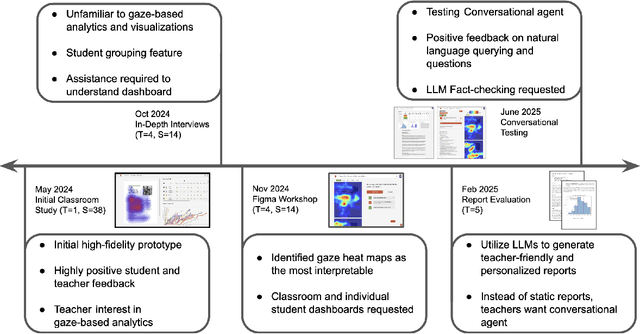
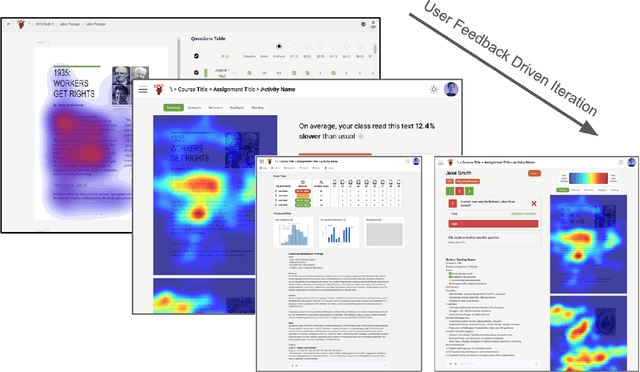
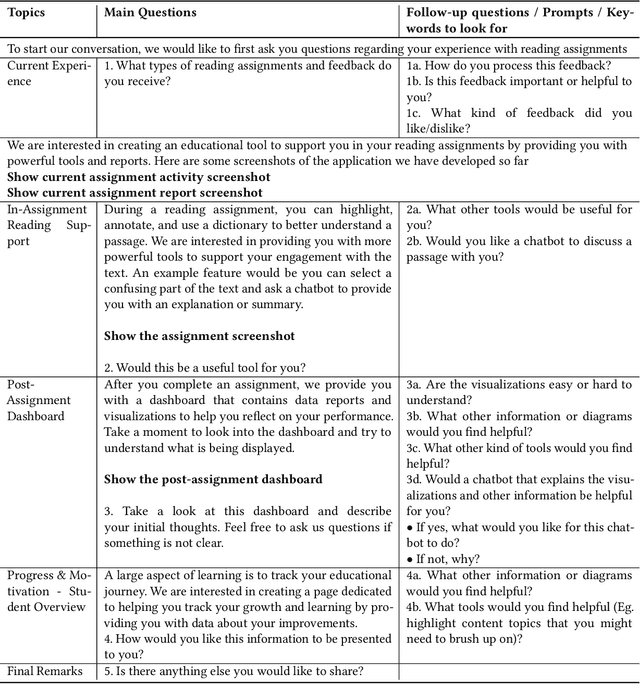
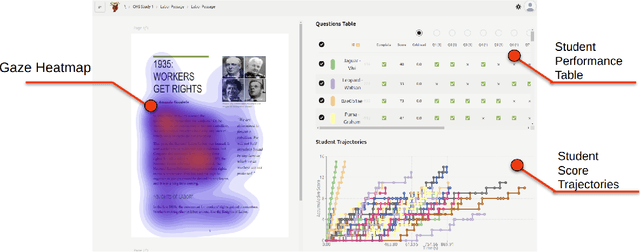
Abstract:Eye-tracking offers rich insights into student cognition and engagement, but remains underutilized in classroom-facing educational technology due to challenges in data interpretation and accessibility. In this paper, we present the iterative design and evaluation of a gaze-based learning analytics dashboard for English Language Arts (ELA), developed through five studies involving teachers and students. Guided by user-centered design and data storytelling principles, we explored how gaze data can support reflection, formative assessment, and instructional decision-making. Our findings demonstrate that gaze analytics can be approachable and pedagogically valuable when supported by familiar visualizations, layered explanations, and narrative scaffolds. We further show how a conversational agent, powered by a large language model (LLM), can lower cognitive barriers to interpreting gaze data by enabling natural language interactions with multimodal learning analytics. We conclude with design implications for future EdTech systems that aim to integrate novel data modalities in classroom contexts.
WEBEYETRACK: Scalable Eye-Tracking for the Browser via On-Device Few-Shot Personalization
Aug 27, 2025Abstract:With advancements in AI, new gaze estimation methods are exceeding state-of-the-art (SOTA) benchmarks, but their real-world application reveals a gap with commercial eye-tracking solutions. Factors like model size, inference time, and privacy often go unaddressed. Meanwhile, webcam-based eye-tracking methods lack sufficient accuracy, in particular due to head movement. To tackle these issues, we introduce We bEyeTrack, a framework that integrates lightweight SOTA gaze estimation models directly in the browser. It incorporates model-based head pose estimation and on-device few-shot learning with as few as nine calibration samples (k < 9). WebEyeTrack adapts to new users, achieving SOTA performance with an error margin of 2.32 cm on GazeCapture and real-time inference speeds of 2.4 milliseconds on an iPhone 14. Our open-source code is available at https://github.com/RedForestAi/WebEyeTrack.
Personalizing Student-Agent Interactions Using Log-Contextualized Retrieval Augmented Generation (RAG)
May 22, 2025Abstract:Collaborative dialogue offers rich insights into students' learning and critical thinking. This is essential for adapting pedagogical agents to students' learning and problem-solving skills in STEM+C settings. While large language models (LLMs) facilitate dynamic pedagogical interactions, potential hallucinations can undermine confidence, trust, and instructional value. Retrieval-augmented generation (RAG) grounds LLM outputs in curated knowledge, but its effectiveness depends on clear semantic links between user input and a knowledge base, which are often weak in student dialogue. We propose log-contextualized RAG (LC-RAG), which enhances RAG retrieval by incorporating environment logs to contextualize collaborative discourse. Our findings show that LC-RAG improves retrieval over a discourse-only baseline and allows our collaborative peer agent, Copa, to deliver relevant, personalized guidance that supports students' critical thinking and epistemic decision-making in a collaborative computational modeling environment, XYZ.
CoTAL: Human-in-the-Loop Prompt Engineering, Chain-of-Thought Reasoning, and Active Learning for Generalizable Formative Assessment Scoring
Apr 03, 2025
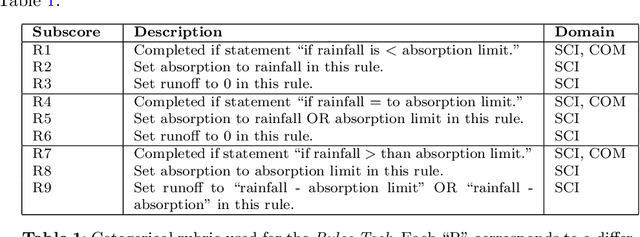
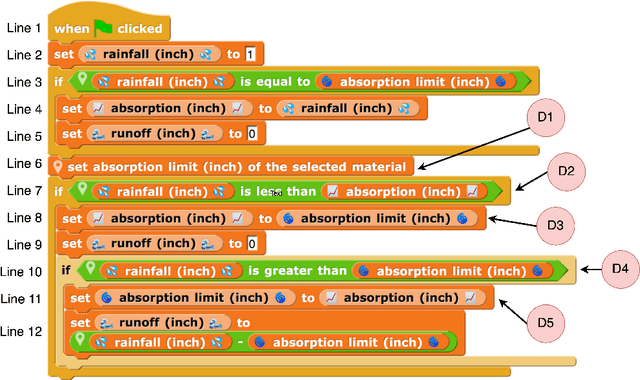
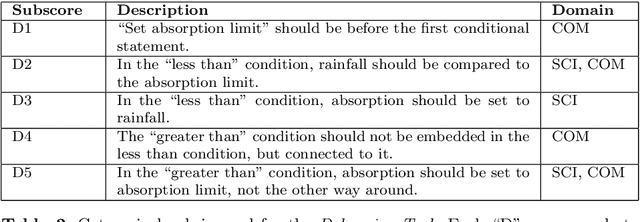
Abstract:Large language models (LLMs) have created new opportunities to assist teachers and support student learning. Methods such as chain-of-thought (CoT) prompting enable LLMs to grade formative assessments in science, providing scores and relevant feedback to students. However, the extent to which these methods generalize across curricula in multiple domains (such as science, computing, and engineering) remains largely untested. In this paper, we introduce Chain-of-Thought Prompting + Active Learning (CoTAL), an LLM-based approach to formative assessment scoring that (1) leverages Evidence-Centered Design (ECD) principles to develop curriculum-aligned formative assessments and rubrics, (2) applies human-in-the-loop prompt engineering to automate response scoring, and (3) incorporates teacher and student feedback to iteratively refine assessment questions, grading rubrics, and LLM prompts for automated grading. Our findings demonstrate that CoTAL improves GPT-4's scoring performance, achieving gains of up to 24.5% over a non-prompt-engineered baseline. Both teachers and students view CoTAL as effective in scoring and explaining student responses, each providing valuable refinements to enhance grading accuracy and explanation quality.
LLMs as Educational Analysts: Transforming Multimodal Data Traces into Actionable Reading Assessment Reports
Mar 03, 2025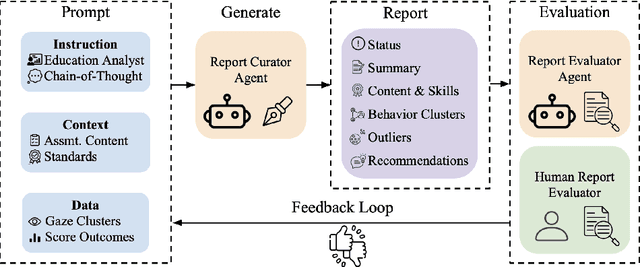
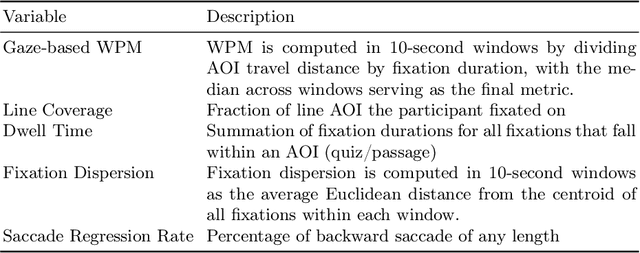
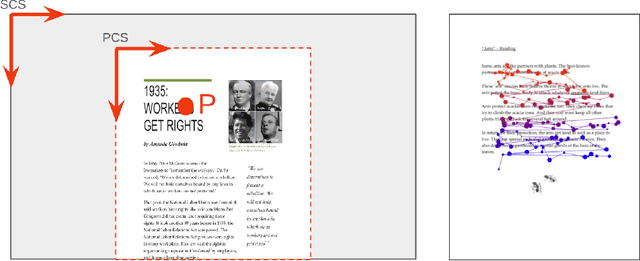

Abstract:Reading assessments are essential for enhancing students' comprehension, yet many EdTech applications focus mainly on outcome-based metrics, providing limited insights into student behavior and cognition. This study investigates the use of multimodal data sources -- including eye-tracking data, learning outcomes, assessment content, and teaching standards -- to derive meaningful reading insights. We employ unsupervised learning techniques to identify distinct reading behavior patterns, and then a large language model (LLM) synthesizes the derived information into actionable reports for educators, streamlining the interpretation process. LLM experts and human educators evaluate these reports for clarity, accuracy, relevance, and pedagogical usefulness. Our findings indicate that LLMs can effectively function as educational analysts, turning diverse data into teacher-friendly insights that are well-received by educators. While promising for automating insight generation, human oversight remains crucial to ensure reliability and fairness. This research advances human-centered AI in education, connecting data-driven analytics with practical classroom applications.
On the Design of Safe Continual RL Methods for Control of Nonlinear Systems
Feb 21, 2025



Abstract:Reinforcement learning (RL) algorithms have been successfully applied to control tasks associated with unmanned aerial vehicles and robotics. In recent years, safe RL has been proposed to allow the safe execution of RL algorithms in industrial and mission-critical systems that operate in closed loops. However, if the system operating conditions change, such as when an unknown fault occurs in the system, typical safe RL algorithms are unable to adapt while retaining past knowledge. Continual reinforcement learning algorithms have been proposed to address this issue. However, the impact of continual adaptation on the system's safety is an understudied problem. In this paper, we study the intersection of safe and continual RL. First, we empirically demonstrate that a popular continual RL algorithm, online elastic weight consolidation, is unable to satisfy safety constraints in non-linear systems subject to varying operating conditions. Specifically, we study the MuJoCo HalfCheetah and Ant environments with velocity constraints and sudden joint loss non-stationarity. Then, we show that an agent trained using constrained policy optimization, a safe RL algorithm, experiences catastrophic forgetting in continual learning settings. With this in mind, we explore a simple reward-shaping method to ensure that elastic weight consolidation prioritizes remembering both safety and task performance for safety-constrained, non-linear, and non-stationary dynamical systems.
Beyond Instructed Tasks: Recognizing In-the-Wild Reading Behaviors in the Classroom Using Eye Tracking
Jan 30, 2025



Abstract:Understanding reader behaviors such as skimming, deep reading, and scanning is essential for improving educational instruction. While prior eye-tracking studies have trained models to recognize reading behaviors, they often rely on instructed reading tasks, which can alter natural behaviors and limit the applicability of these findings to in-the-wild settings. Additionally, there is a lack of clear definitions for reading behavior archetypes in the literature. We conducted a classroom study to address these issues by collecting instructed and in-the-wild reading data. We developed a mixed-method framework, including a human-driven theoretical model, statistical analyses, and an AI classifier, to differentiate reading behaviors based on their velocity, density, and sequentiality. Our lightweight 2D CNN achieved an F1 score of 0.8 for behavior recognition, providing a robust approach for understanding in-the-wild reading. This work advances our ability to provide detailed behavioral insights to educators, supporting more targeted and effective assessment and instruction.
AAAI Workshop on AI Planning for Cyber-Physical Systems -- CAIPI24
Oct 08, 2024Abstract:The workshop 'AI-based Planning for Cyber-Physical Systems', which took place on February 26, 2024, as part of the 38th Annual AAAI Conference on Artificial Intelligence in Vancouver, Canada, brought together researchers to discuss recent advances in AI planning methods for Cyber-Physical Systems (CPS). CPS pose a major challenge due to their complexity and data-intensive nature, which often exceeds the capabilities of traditional planning algorithms. The workshop highlighted new approaches such as neuro-symbolic architectures, large language models (LLMs), deep reinforcement learning and advances in symbolic planning. These techniques are promising when it comes to managing the complexity of CPS and have potential for real-world applications.
Multimodal Methods for Analyzing Learning and Training Environments: A Systematic Literature Review
Aug 22, 2024



Abstract:Recent technological advancements have enhanced our ability to collect and analyze rich multimodal data (e.g., speech, video, and eye gaze) to better inform learning and training experiences. While previous reviews have focused on parts of the multimodal pipeline (e.g., conceptual models and data fusion), a comprehensive literature review on the methods informing multimodal learning and training environments has not been conducted. This literature review provides an in-depth analysis of research methods in these environments, proposing a taxonomy and framework that encapsulates recent methodological advances in this field and characterizes the multimodal domain in terms of five modality groups: Natural Language, Video, Sensors, Human-Centered, and Environment Logs. We introduce a novel data fusion category -- mid fusion -- and a graph-based technique for refining literature reviews, termed citation graph pruning. Our analysis reveals that leveraging multiple modalities offers a more holistic understanding of the behaviors and outcomes of learners and trainees. Even when multimodality does not enhance predictive accuracy, it often uncovers patterns that contextualize and elucidate unimodal data, revealing subtleties that a single modality may miss. However, there remains a need for further research to bridge the divide between multimodal learning and training studies and foundational AI research.
FT-AED: Benchmark Dataset for Early Freeway Traffic Anomalous Event Detection
Jun 24, 2024



Abstract:Early and accurate detection of anomalous events on the freeway, such as accidents, can improve emergency response and clearance. However, existing delays and errors in event identification and reporting make it a difficult problem to solve. Current large-scale freeway traffic datasets are not designed for anomaly detection and ignore these challenges. In this paper, we introduce the first large-scale lane-level freeway traffic dataset for anomaly detection. Our dataset consists of a month of weekday radar detection sensor data collected in 4 lanes along an 18-mile stretch of Interstate 24 heading toward Nashville, TN, comprising over 3.7 million sensor measurements. We also collect official crash reports from the Nashville Traffic Management Center and manually label all other potential anomalies in the dataset. To show the potential for our dataset to be used in future machine learning and traffic research, we benchmark numerous deep learning anomaly detection models on our dataset. We find that unsupervised graph neural network autoencoders are a promising solution for this problem and that ignoring spatial relationships leads to decreased performance. We demonstrate that our methods can reduce reporting delays by over 10 minutes on average while detecting 75% of crashes. Our dataset and all preprocessing code needed to get started are publicly released at https://vu.edu/ft-aed/ to facilitate future research.
 Add to Chrome
Add to Chrome Add to Firefox
Add to Firefox Add to Edge
Add to Edge